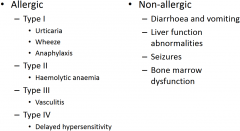![]()
![]()
![]()
Use LEFT and RIGHT arrow keys to navigate between flashcards;
Use UP and DOWN arrow keys to flip the card;
H to show hint;
A reads text to speech;
17 Cards in this Set
- Front
- Back
|
What is meant by antibiotic stewardship? |
•Reduce antibiotic consumption
•Restrict worst offender agents •Promote logical antibiotic choices •Limit “co-lateral damage” |
|
|
What s meant by guided therapy? Give an example |
- Depends on identifying cause of infection and selecting agent based on sensitivity testing - cystits or mild wound infections |
|
|
What is meant by empirical therapy? Give an example. |
–Best (educated) guess therapy based on clinical/epidemiological acumen –Used when therapy cannot wait for culture –Sepsis and Meningitis |
|
|
What is mean by prophylactic therapy? Give an example |
preventing infection before it begins –HIV, Transplantation |
|
|
List 6 ideal characteristics for an antibiotic |
- highly toxic to bacteria causing infection - penetrates the area of infection - convenient administration - non-toxic to patient - limited damage to resident bacteria - low propensity for resistance |
|
|
Which types of antibiotic are most suitable for guide and empirical therapy |
guided: narrow spectrum empirical: broad spectrum |
|
|
Define bactereicidal and bacteristatic |
bactericidal: kills bacteria bacteristatic: inhibits growth or reproduction |
|
|
List 4 targets on a bacterial cell for antibiotics and give an example of each |
- ribosome: macrolides and aminoglycosides - DNA: quinolones - metabolsim: trimethroprim - cell wall: penicillins and glycopeptides |
|
|
Give an overview of penicillins (beta lactams) and their mechanism of action |
- broad spectrum (though variable potency) with low toxicity - can cause type I-IV hypersensitivities and other adverse effects - has beta-lactam ring which targets enzymes in the cell wall called penicillin binding protiens - prevents cross-linking of the cell wall (wall synthesis) - leads to death through osmotic instability or autolysis |
|
|
What are the potential adverse effects of beta lactams |

|
|
|
What is the mechanism of action of glycopeptides (e.g. vancomycin)? What is its main use? |
-bind toprecursors of cell wall synthesis which leads to interference of thepenicillin-binding protein (PBP) enzymes such as transpeptidases to incorporate the precursors into the growing cell wall. - With this,cell wall synthesis stops and cell death often follows. - mainly for MRSA |
|
|
What is the MOA of macrolides |
- protein synthesis inhibitor -bind to and inhibit CYP-3A4 - prevent peptide chain extension - bacteristatic |
|
|
What is the MOA of aminoglycosides? What are some of its adverse effects |
- reversibly bind to 30S ribosome - bacteristatic - also has a bactericidal effect at high concentrations due to poorly understood effect on cell membrane - can cause nephrotoxicity, ototoxicity (hearing, loss of balance, disturbed vision) and neuromuscular blockade |
|
|
What is the MOA of quinolones? |
- bactericidal and broad spectrum - inhibit bacterial DNA gyrase needed for replication |
|
|
What is the MOA of trimethoprim? |
- bacteristatic - inhibit folate metabolism preventing DNA synthesis - can cause renal toxicity |
|
|
Give three mechanisms of antibiotic resistance |
- mutations at target site - inactivating enzymes - reduced access e.g. efflux of reduced permeability |
|
|
How has resistance to beta lactams developed? Can these be countered? |
- mutation of targets - penicillin binding proteins - production of beta-lactamases: enzymes that lyse and deactivate beta lactams - beta lactamase inhibitors can be co-administered, increasing spectrum and potency |

